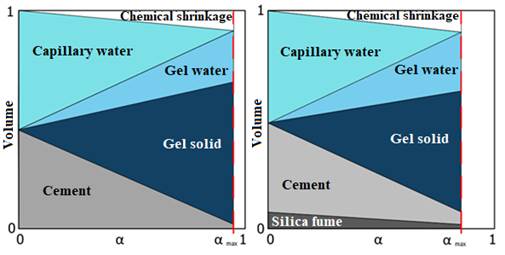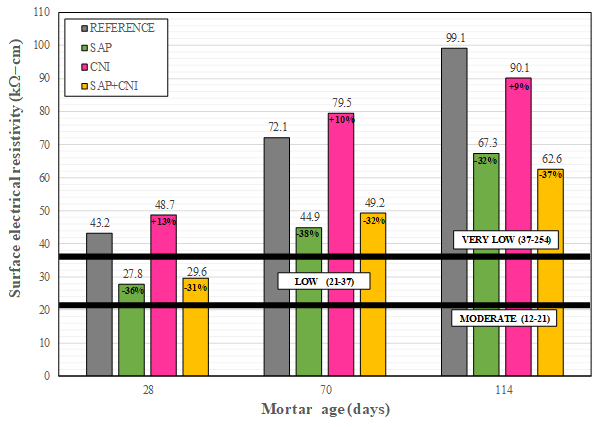| Basic Research | https://doi.org/10.21041/ra.v10i2.450 |
Synergetic effect of a super-absorbent polymer and a calcium nitrite corrosion inhibitor in high performance concrete durability
Efeito sinérgico de um polímero super absorvente e um aditivo inibidor de corrosão à base de nitrito de cálcio na durabilidade do concreto de alto desempenho
Efecto sinergético de un polímero súper-absorbente y un inhibidor de corrosión de nitrito de calcio en la durabilidad de un concreto de alto desempeño
A.
Durán-Herrera1
*
![]() ,
J. A.
Canul-Polanco1
,
J. A.
Canul-Polanco1
![]() ,
R.
Dávila-Pompermayer1
,
R.
Dávila-Pompermayer1
![]() ,
L. G.
López-Yépez1
,
L. G.
López-Yépez1
![]() ,
P.
Valdez-Tamez1
,
P.
Valdez-Tamez1
![]()
1 Universidad Autónoma de Nuevo León, Facultad de Ingeniería Civil, Nuevo León, México..
* Contact author: alejandro.duranhr@gmail.com
Reception: November 22, 2019.
Acceptance: March 05, 2020.
Publication: April 30, 2020
| Cite as: Durán-Herrera, A., Canul-Polanco, J. A., Dávila-Pompermayer, R., López-Yépez, L. G., Valdez-Tamez, P. (2020), "Synergetic effect of a superabsorbent polymer and a calcium nitrite corrosion inhibitor in high performance concrete durability", Revista ALCONPAT, 10 (2), pp. 206 – 218, DOI: https://doi.org/10.21041/ra.v10i2.450. |
Abstract
In this research, the synergetic effect of a super-absorbent polymer in combination with a calcium nitrite corrosion inhibitor were evaluated as a combined technology to improve concrete durability in High Performance Concrete. For this purpose, Portland cement mortars with a water/cement ratio of 0.4 and a substitution of 9.5% of cement by silica fume were produced. The effect of this technologies was evaluated by measuring the following parameters: autogenous and drying shrinkage, surface electrical resistivity and the non-steady-state chloride migration coefficient. The results indicate that the synergistic effect of SAP + CNI improves autogenous shrinkage and surface electrical resistivity.
Keywords:
high performance concrete,
super-absorbent polymer,
calcium nitrite corrosion inhibitor,
silica fume,
durability.
Resumo
Nesta pesquisa, o efeito sinergético de um polímero super absorvente (SAP) e um inibidor de corrosão do nitrito de cálcio (CNI) foi avaliado como uma tecnologia combinada para melhorar a durabilidade do Concreto de Alto Desempenho. Para isso, foram produzidas argamassas de cimento Portland com uma relação água/cimento de 0,4 e uma adição de 9,5% de sílica ativa. O efeito dessas tecnologias foi avaliado medindo-se os seguintes parâmetros: retração autógena e por secagem, resistividade elétrica da superfície e coeficiente de migração de cloretos em estado não estacionário. Os resultados indicam que o efeito sinérgico do SAP + CNI melhora a retração autógena e a resistividade elétrica superficial.
Palavras-chave:
concreto de alto desempenho,
polímero super absorvente,
inibidor de corrosão baseado em nitrito de cálcio,
microssilice,
durabilidade.
Resumen
En esta investigación, se evaluó el efecto sinergético de un polímero súper-absorbente en conjunto con un inhibidor de corrosión de nitrito de calcio, como una tecnología combinada para mejorar la durabilidad de un Concreto de Alto Desempeño. Para este propósito, se produjeron morteros de cemento Portland con una proporción de agua/cemento de 0.4 y una substitución de 9.5% de cemento por microsilíce. El efecto de estas tecnologías fue evaluado midiendo los siguientes parámetros: las retracciones autógena y por secado, la resistividad eléctrica superficial y el coeficiente de migración de cloruros en estado no estacionario. Los resultados indican que el efecto sinérgico del SAP + CNI mejora la retracción autógena y la resistividad eléctrica superficial.
Palabras clave:
concreto de alto desempeño,
polímero súper-absorbente,
inhibidor de la corrosión de nitrito de calcio,
microsílice,
durabilidad
1. Introduction
It is well known that high performance concrete (HPC) has better mechanical and durability properties than conventional concrete (Zhutovsky S. et. al., 2012). In HPC, supplementary cementitious materials (SCM), such as silica fume (SF) are commonly used to achieve a superior performance in terms of mechanical and durability performance (Lothenbach B. et. al., 2011). However, despite these benefits, the presence of silica fume in HPC could adversely originate early age cracking attributed to the hydration process (Pendergrass B. et. Al., 2014).
Calcium nitrite admixtures (CNI) are used as corrosion inhibitors since the 1980´s to extend the service life of reinforced concrete, and are commonly used in HPC for marine constructions (Gaidis J.M., 2004). In the presence of CNI, concrete setting times could be delayed (M.A. Quraishi, et. al., 2016; Hansson C.M. et al., 1998), but in this work we are expecting that the presence of SF could counteract this delay.
Because the fineness of SF, it is well knowknown that in the presence of this SCM, concrete shrinkage will be increased, mainly at early ages. With the inclusion of CNI we are expecting that shrinkage could be further augmented and consequently the a reduction of the potential durability. Therefore, a proposed solution to this issue could be the implementation of internal curing trough a superabsorbent polymer (SAP).
For the positive results it has shown to mitigate early age shrinkage (Snoeck D. et al., 2015), internal curing is known as a feasible technology to diminish the early age cracking of HPC (Craeye B. et al., 2011; Cusson D. et al., 2010). TheseThis technology consists in the introduction of a porous material within the fresh concrete, a highly porous material that could absorb a significant amount of water that will be released within the porous network of concrete as the relative humidity and internal pore pressure decreases. For this purpose, superabsorbent polymers and lightweight aggregates are the most common agents used to implement internal curing (Jensen O. et. Al al., 2001). However, the use of SAP has proved a better performance in terms of water absorption capacity (Mechtcherine V. et. Al al., 2012).
To implement this technology in HPC, the dosage of superabsorbent polymer that should be used could be determined through the modified Powers hydration model (T.C. Powers, et. Al al., 1948; Jensen O. et al., 2000; Jensen O. et al., 2002), a model that is explained by two different hydration systems, an open water-entrained system and a closed system isolated from an external source of water. Figure 1 illustrates the importance of internal curing in HPC, because in this concretes, the higher densification level of the cementitious matrix will prevent external curing to be effective (water penetration) through all the depth of concrete, a condition that could be solved through the implementation of internal curing.
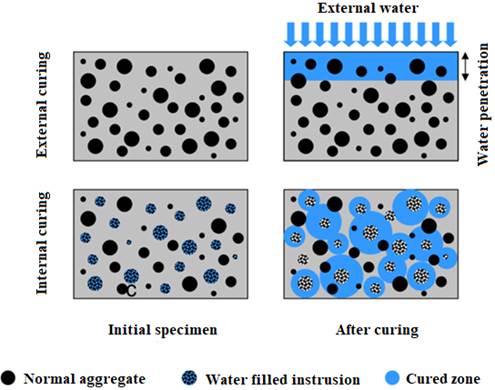
Figure 1.
Internal water curing vs external water curing in HPC (I. De la Varga et al., 2012
Hence, returning to the concern of the use of CNI and SF in concrete. Because CNI could modify the setting time and hydration rate of a cementitious matrix (M.A. Quraishi, et al., 2016; Hansson C.M. et al., 1998), it is expected that the internal curing method with SAP could decrease these mentioned effects.
Most of the published research work about the effect of CNI in portland cement based concrete, evaluate the effect of this admixture through corrosion electrochemical tests, but leave aside the evaluation of the effect of this admixture regarding setting times and hydration rate (Hansson C.M. et al., 1998). In this project, is expected that the internal curing method with SAP will influence the hydration of the cementitious system and counteract the setting times delay associated to the presence of CNI, therefor it was mainly focused in the evaluation of the synergetic effect of CNI and SAP in fresh and hardened stage properties of an HPC with SF, such as: autogenous shrinkage, drying shrinkage, surface electrical resistivity and the non-steady chloride migration coefficient.
2. Procedure
Materials used for the production of the mortars:
Mortars were prepared with a w/c of 0.40 and a silica fume addition of 9.5% by mass. The paste proportions were established according to the modified hydration Powers model for Portland Cement-Silica Fume (PC-SF) cementitious systems (T.C. Powers, et. Al., 1948; Jensen O. et al., 2000; Jensen O. et al., 2002), that analytically evaluate the hydration degree (α) for the same cementitious matrix exposed to an external open curing system or to an internal closed system isolated from the external curing water. For this project, the system was closed isolated with and without internal curing (see figure 2). The diagram in figure 2 present the volumetric phase distribution in a cementitious paste: capillary water, gel water (pw) gel solid (bw), and chemical shrinkage (CS). The CS and bw were calculated by the Test ASTM C 1608 and thermogravimetric analysis (TGA) correspondingly. The gel water amount was considered 0.19 g/g for cement and 0.5 g/g for silica fume (Sellevold E. J. et al., 1998).
Equation 1 was used to calculate bw:

(1)
Where:
The required amount of internal curing water (ICw) to mitigate autogenous shrinkage in a Portland cement-silica fume cementitious paste with a w/c ratio of 0.40 was calculated according to equations 2 and 3:

(2)

(3)
Where:
The dosage of CNI was 2% respect to the mass of the cementitious materials. A target consistency (spread) of 24 ± 1 cm was established for the whole set of mortar mixtures, and it was measured in the ASTM C 230 flow table, according to the procedure described in ASTM C 1437, but without the drops specified in the standard procedure. To maintain constant the water-to-cement ratio, the amount of water in the admixtures was considered as part of the reaction water. Mixtures were prepared in an epicyclical type mixer that meets the requirements of ASTM C 305, through the following mixing procedure:
For the whole set of mortars, the fresh stage properties characterization consisted on the determination of the consistency (spread) according to ASTM C 1437, but without any drop of the flow table; the air content and unit weight were determined according to ASTM C 85. Autogenous shrinkage was evaluated according to ASTM C 1698, after the final setting time of the concrete but in the mortar fraction of the material determined according ASTM C 403, and up to an age of 28 days. Measurements of the lineal autogenous strain was made by triplicate trough a flexible corrugated mold and a dilatometer.
The four mixtures evaluated in this work are identified according to the nomenclature that appears in table 1, and the proportions for all these mixtures, with the aggregated in dry condition are reported in table 2.
Table 1. Mixture identifications (ID)
ID
Materials
REF
PC + SF
SAP
PC + SF + SAP
CNI
PC + SF + CNI
SAP+CNI
PC + SF + SAP + CNI
Table 2. Mixture proportions in kg/m3, FA in dry condition
Mixture
OPC
SF
Water
ICw
SP
FA
SAP
CNI
REF
485.1
46.1
225.7
----
3.2
1513.8
----
----
SAP
481.7
45.8
224.1
32.5
3.2
1414.3
1.4
----
CNI
485.8
46.1
220.9
----
3.2
1506.7
----
10.7
SAP+CNI
481.3
45.7
217.0
32.5
3.2
1404.3
1.4
10.6
At the end of the mixing process, prismatic specimens with dimensions of 50 x 50 x 250 mm, were casted for the determination of the drying shrinkage, according to ASTM C 596 (four samples were casted for each mixture); cylindrical specimens with dimensions of 10 cm in diameter by 20 cm in height, were casted to perform the surface electrical resistivity tests (SER) according to AASHTO TP 95, with a device that operates according to the Four-Point Wenner Array Probe Test (AASHTO TP 95, 2011), as well as the non-steady chloride migration coefficient according to NT Build 492). The results of these two methods present good correlations and are commonly reported as durability indexes of concrete and as an indicator of the cement paste quality (T.C. Powers, et. Al., 1948). Specimens were demolded at 24 hours and placed in a curing room that meets the required controlled conditions established by ASTM C 31 (23°C ± 2°C and RH ≥ 95%).
3. Results and discussion
3.1 Hydration parameters
For OPC and SF, the hydration parameters were obtained from the Powers Model (T.C. Powers, et al., 1948; Jensen O. et al., 2000; Jensen O. et al., 2002) trough TGA (including the determination of the amount of calcium hydroxide, CH) and CS measurements, and were calculated according to equation 1-3. The results were used to calculate the internal curing water and the amount of SAP to be dosed and are summarized in in Table 3.
Table 3. Hydration parameters of the cementitious materials from TGA and CS measurements
Cementitious
bw (g/g)
pw (g/g)
CS (ml/100g)
CH g/g
(α)
OPC
0.23
0.19
6.03
0.16
1
SF
0
0.5
19.66
1.7
------
Through equations 1-3 and the values reported for the hydration parameters in Table 3, theoretically indicate that in a closed system the cementitious paste (OPC and SF) will reach a α of 1 if the final w/c ratio is 0.47. In our experimental work, the cementitious paste was set to have a w/c ratio of 0.40 and an s/c of 0.095, therefore in order to reach a w/c of 0.47; the amount of internal curing water to add in terms of w/c ratio should be 0.07. The required mass of water for internal curing (ICw), and the required dosage of SAP to implement internal curing within the mortar, are reported in table 4.
Table 4. Parameters to calculate the amounts of ICw and SAP to implement internal curing in a closed water system.
w/cclosed
w/c
X
s/c
ICw (kg/m3)
SAP (kg/m3)
0.47
0.40
0.07
0.095
33.8
1.5

3.2 Fresh stage properties
The fresh stage properties are presented in table 5. All the mixtures achieved the target spread of 24 ± 1 cm. The results of air content and unit weight exhibit that the substitution of sand by SAP increased the air content and subsequently decreased the unit weight. For mixtures CNI and CNI+SAP, the fresh stage properties were similar to the reference mixture.
Table 5. Fresh stage properties of mortars
Mixture
Spread (cm)
Air content (%)
Unit weight (kg/m3)
REF
24
1.4
2359
SAP
24
2.1
2283
CNI
24
1.3
2358
CNI+SAP
23
2.4
2295
Table 6. Setting times
Mixture
Initial (min)
Final (min)
REF
220
285
SAP
297
383
CNI
195
245
SAP+CNI
248
307
Because it is known that CNI could have an influence on the setting times (Hansson C.M. et al., 1998) and that SAP could also decrease setting times, the determination of this property was included in the experimental program of this work. The results of setting times reported in Table 6 indicate that alone, the dosages of CNI accelerate the initial and final setting times by 25 and 40 minutes, and that SAP delay these setting times by 1h:17m and 1h:38m respectively. In mixture SAP+CNI, the combined effect leads to a negligible delay in the initial and final setting times, of 28 and 22 minutes respectively. The acceleration or delay in setting times originated by CNI, SAP and SAP+CNI are negligible and do not represent any problem for practical applications.
3.3 Autogenous and drying shrinkage.
The results of autogenous shrinkage (AS) presented in Figure 3 at ages of 64 hours and 28 days exhibit the great benefit of SAP to counteract AS by 97% and 89% respectively. The presence of CNI significantly increases AS by 89% and 78% respectively, but in combination with SAP this undesired performance was opposite counteracting the volumetric instability and leading to AS reductions of 79% and 69% respectively.
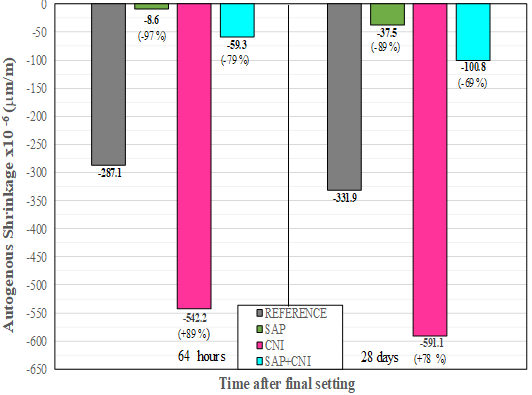
Figure 3.
Autogenous shrinkage at 64 hours and 28 days
For Reference, SAP and CNI mixtures, the results of drying shrinkage (DS) reported in Figure 4, at an age of 70 days (595, 620 and 645 µm respectively), clearly illustrate that SAP and CNI do not have a mayor effect in this property, however, by combining the two admixtures, DS increases to 765 µm, representing a minor increase of 145 µm in comparison to the average DS of the other three mixtures (620 µm).
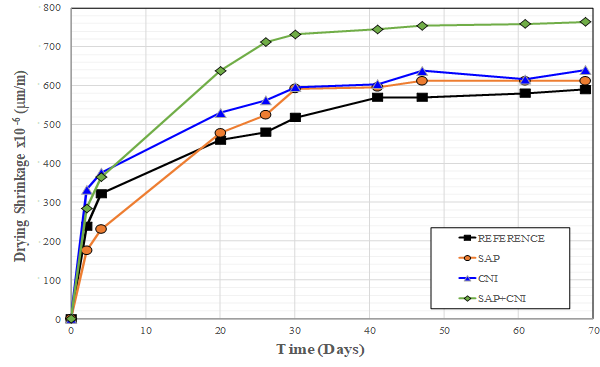
Figure 4.
Drying shrinkage at the age 70 days
3.4 Surface electrical resistivity (SER) and chloride migration coefficient (Dnssm)
The results reported in Figure 5, indicate that for all the ages reported in this figure, CNI slightly improved SER within a range of 10% to 13%. According to the qualitative classification reported in the standard test method for this tests AASHTO TP 95, the results for reference and CNI mixtures present a very low chloride Ion Permeability Potential. At 28 days, the presence of SAP originates a reduction of 36%, suggesting that the chloride ion permeability potential was affected and passes from very low to low, however at 70 and 114 days the reductions remains almost the same (38% and 32%), also that at this two ages the concrete recovers the very low chloride ion permeability potential. Mixture SAP + CNI presented a similar trend with reductions of 31%, 32% and 37% at the ages of 28, 70 and 114 days respectively.
Surface electrical resistivity is an indirect measure of both porosity and diffusivity. The electrical current flowing through the hydrated paste is due to an electrolytic process mainly resulting from the flow of ions present in the pore solution (K. O. Ampadu, et al., 1999) on the other hand, when the concentration of ionic species such as sodium and potassium decreases, this will lead to a decrease in ionic conductivity and therefore to an increase of the electrical resistivity (C. Shi, 2004). It seems that the increase of SER, originated by the presence of CNI, is the result of the decrease in the flow of electric current because of the probable decrease in ionic conductivity in the pore solution.
Among others, factors that affect SER results are porosity, water content, the presence of supplementary cementitious materials and the w/c ratio. For mixtures with CNI it is also important to highlight that this technique could provide slightly underestimated results (AASHTO TP 95, 2011).
Results in Table 7 indicate that the three technologies (SAP, CNI and SAP+CNI) increased Dnssm by 38, 30 and 122%. Even though, these increments could be perceived as very high, the qualitative classification established for this test method (Nilsson L., et al., 1998) indicate that for HPC with these technologies, the potential resistance to the ingress of chlorides is extremely high (Dnssm < 2.5x10-2m2/s) for mixtures SAP and CNI, and very high (Dnssm = 2.2 - 5.0x10-12m2/s) for mixture SAP+CNI. The coefficients of variation reported in table 7 are included as a reference of the uncertainty that could be expected for measurements made by triplicate.
Analysing the absolute differences for setting times, SER and Dnssm, we can observe that mixtures with SAP presented the higher values. This behaviour is attributed mainly to the increase in the water/cementitious ratio that could result during the very early ages, because it is considered that SAP does not effectively retain all calculated internal curing water, liberating part of it in a period comprised between the time when the specimens were casted and the time when the concrete reach its final setting time. Even though this slight adverse effect of SAP results, SER and Dnssm indicates that in terms of durability (cualitative) the effect is negligible.
Table 7. Chloride Migration Coefficient (Dnssm) at 114 days
Mixture
Dnssm (x 10-12 m2/s)
Coefficient of variation (%)
REF
1.46
4.44
SAP
2.01
7.04
CNI
1.90
5.03
SAP+CNI
3.25
9.14
If the SAP voids are empty, ions have to travel a slightly longer route to pass the void, but if SAP voids are full with liquid, they may provide an expressway without obstacles for ion transport. However, the liquid in the void may be wholly or partly held within a swelled SAP particle and the transport properties in a swelled SAP particle are not known (Marianne T. H. et al., 2015). This statement could be the reason of the higher coefficients (Dnssm) obtained for the mixtures with SAP.
4. Summary and conclusions
Based in the analysis of the results obtained for the mortars evaluated in this work, the following conclusions can be drawn:
5. Acknowledgements
The authors wish to express their gratitude and sincere appreciation to the different organizations that contributed in the development of this project; to the Consejo Nacional de Ciencia y Tecnología of Mexico (CONACYT) for the scholarship granted to Jennifer A. Canul-Polanco, to the Scientific and Technological Research Program of the Universidad Autónoma de Nuevo León (PACyT-UANL) and to the Program for the Promotion and Consolidation of Technological Research and Development Projects of the Facultad de Ingeniería Civil (FIC-UANL). Also, the authors wish to express their gratitude to José Alfredo Rodríguez Campos, from HOLCIM México S.A. de C.V.; and to Filiberto Marin, from EUCOMEX S.A. de C.V., for providing the Portland cement and the Chemical admixtures respectively.
References
American Association of State Highway and Transportation Officials. (2011). AASHTO TP 95: Standard Method of Test for Surface Resistivity Indication of Concrete’s Ability to Resist Chloride Ion Penetration. Washington, DC.
Ampadu, K. O., Torii, K., Kawamura, M. (1999), Beneficial effect of fly ash on chloride diffusivity of hardened cement paste, Cement and Concrete Research, 29 (4), 585-590. https://doi.org/10.1016/S0008-8846(99)00047-2
Craeye, B., Geirnaert, M., DeSchuttera, G. (2011), Super absorbing polymers as an internal curing agent for mitigation of early-age cracking of high-performance concrete bridge decks. Construction and Building Materials. 25, 1-13. https://doi.org/10.1016/j.conbuildmat.2010.06.063.
Cusson, D., Lounis, Z., Daigle, L. (2010), Benefits of internal curing on service life and life-cycle cost of high-performance concrete bridge decks - A case study. Construction and Building Materials, 32, 339-350 https://doi.org/10.1016/j.cemconcomp.2010.02.007.
De la Varga Castro, J., Bentz, D., Weiss, J. (2012), Application of internal curing for mixtures containing high volumes of fly ash. Cement & Concrete Composites, 34 1001-1008, https://doi.org/10.1016/j.cemconcomp.2012.06.008.
Gaidis, J. M. (2004). Chemistry of corrosion inhibitors. Cement and Concrete Composites, Vol. 26, pp. 181-189. https://doi.org/10.1016/S0958-9465(03)00037-4.
Hansson, C. M., Mammoliti, L., Hope, B. B. (1998). Corrosion Inhibitors in concrete Part I - Principles. Cement and Concrete Research, Vol. 28, No. 12, pp. 1775-1781. https://doi.org/10.1016/S0008-8846(98)00142-2.
Jensen, O., Hansen, P. F. (2001), Water-entrained cement-based materials, PCT Patent Application WO01/02317A1.
Jensen, O., Hansen, P. F. (2001), Water-entrained cement-based materials I. Principles and theoretical background, Cement and Concrete Research, Volume 31, Issue 4, pages 647-654. https://doi.org/10.1016/S0008-8846(01)00463-X.
Jensen, O., Hansen, P. F. (2002), Water-entrained cement-based materials II. Experimental observations, Cement and Concrete Research, Volume 32, Issue 6, June pages 973-978. https://doi.org/10.1016/S0008-8846(02)00737-8.
Lothenbach, B., Scrivener, K., Hooton, R. D. (2011), Supplementary cementitious materials, Cement and Concrete Research Num. 41 1244-1256. https://doi.org/10.1016/j.cemconres.2010.12.001.
Mechtcherine, V., Reinhardt, H. (2012), Application of Superabsorbent Polymers (SAP) in Concrete Construction State of the Art Report Prepared by Technical Committee 225-SAP, https://doi.org/10.1007/978-94-007-2733-5.
Nordest (1999), NT Build 492: Concrete, mortar and cement-based repair materials: Chloride migration coefficient from non-steady-state migration experiments.
Nilsson, L., Ngo, M., Gjørv, O. (1998). High-performance repair materials for concrete structures in the port of Gothenburg. En O. Gjørv, K. Sakai, & N. Banthia, Concrete under severe conditions: environment and loading, volumen 2, pp 1193-1198. Tromsø, Norway: E & FN Spon. https://doi.org/10.1201/b16469.
Pendergrass, B., Darwin, D. (2014), Low-cracking High-Performance Concrete (LC-HPC) bridge decks: Shrinkage-Reducing Admixtures, Internal Curing, and cracking performance. Structural Engineering and Engineering Materials SM Report no. 107. The University of Kansas Center for Research, INC, Lawrence Kansas. https://kuscholarworks.ku.edu/handle/1808/19821.
Powers, T. C., Brownyard, T. L. (1948) Studies of the physical properties of hardened Portland Cement pastes, Journal of the American Concrete Institute, USA.
Quraishi, M. A., Nayak, D. K., Singh, B. N., Kumar, V., Pandey, K. K. (2016), Experimental Studies on Effects of Sodium Citrate, Calcium Nitrite and Hexamine as Corrosion Inhibitor in Concrete; Journal of Steel Structures & Construction, 5 pp; doi: 10.4172/2472-0437.1000117.
Sellevold, E. J., Radjy, F. F. (1982), Condensed silica fume in concrete, Report BML 82.610. Division of Building Materials. The Norwegian Institute of Technology & The University of Trondheim, Norway.
Shi, C. (2004), Effect of mixing proportions of concrete on its electrical conductivity and the rapid permeability test (ASTM C1202 or ASSHTO T277) results, Cement and Concrete Research, 34 (3), 537-545. https://doi.org/10.1016/j.cemconres.2003.09.007.
Snoeck, D., Jensen, O. M., De Belie, N. (2015), The influence of superabsorbent polymers on the autogenous shrinkage properties of cement pastes with supplementary cementitious materials. Cement and concrete research 74, 59-67. https://doi.org/10.1016/j.cemconres.2015.03.020.
Tange Hasholt, M., Mejlhede Jensen, O. (2015), Chloride migration in concrete with superabsorbent polymers, Cement and Concrete Composites, 55, 290-297. https://doi.org/10.1016/j.cemconcomp.2014.09.023.
Zhutovsky S. and Kovler K. Effect of internal curing on durability-related properties of high performance concrete, Cement and concrete research (2012), vol. 42., 1, pages 20-26, https://doi.org/10.1016/j.cemconres.2011.07.012.

